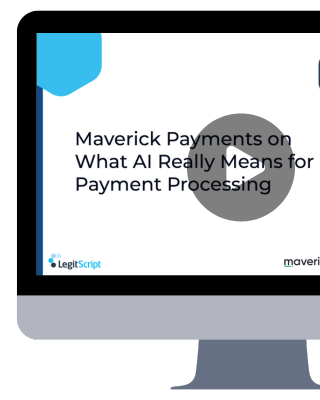Artificial intelligence (AI) may be one of the hottest topics in payment processing, but industry leaders say its role in payments is an opportunity that requires a thoughtful approach and critical thinking. That was the central theme of LegitScript's recent webinar, “Maverick Payments on What AI Really Means for Payment Processing.” Read our key takeaways below and then watch the full conversation.

August 20, 2025 | by LegitScript Folks
The conversation, featuring Justin Downey, VP of Product at Maverick Payments, and Tom Cook, Chief Product & Technology Officer at LegitScript, examined how AI is being deployed across payments and compliance workflows, where the technology still falls short, and how fraudsters are exploiting it.
AI Adoption Is Rising — but People Are Still Wrestling with How to Use It
A poll of attendees revealed that just under half use at least one AI-powered tool in their daily workflow, while a similar percentage reported they don’t use AI at all. Downey noted that this reflects how most people approach AI today:
“I think where most people are at today, they’re doing the input query, kind of like they would a Google search. And then you’re seeing businesses do a lot of workflow stuff. The agent piece — that’s new, and we’re probably years from really implementing it.”
Cook agreed, adding that the industry is still grappling with the proper way to understand AI:
“There's a notion of agents being the perfect intern. And so if you think about an agent as a perfect intern, you need to understand that they have no context, and they really need to be taught everything about the business. And so when you think about agents at that level, they're very powerful. They can get a lot done, but they have to be watched very carefully.”
Efficiency Gains Without Replacing Humans
Both panelists stressed that AI is best viewed as a supplement to human expertise, not a replacement. From drafting communications to summarizing large volumes of data, AI is already helping teams accelerate routine tasks.
“AI writes a lot more delicately than I do,” Downey said. “It’s way nicer in its responses, and that's a way that you can potentially use it — incorporating some sort of query and workload, but also reviewing and refining data.”
Cook added that AI’s ability to summarize large amounts of data is helpful for executives who need to quickly understand the salient points of an issue. Still, he said it’s important to keep a critical eye on what the AI is producing.
“We’ve seen across the board, even at the executive level, where you can present things, you can summarize large articles or a large body of work and get to the key points … and then be able to present, whether it’s board level, executive level, or staff level,” Cook said. “[However,] you just have to constantly monitor the output or you can get surprises.”
Guardrails and Oversight Are Essential for AI
As businesses explore embedding AI into workflows, the speakers emphasized the importance of governance. AI can generate convincing but inaccurate results, which makes oversight non-negotiable.
“AI is not automation,” Downey said. “Unless you’re incorporating the agent AI that we’re talking about where it can take in information and make certain decisions or reform data, I would use caution with something like that. What you want to do is pair it with [human] knowledge and expertise because there are things that it’s not good at.”
Cook expanded on the risks of deploying AI too cavalierly:
“What you need to do when you build these things is test, test, test. You need to run these things over and over again and make sure that you're getting the right response.”
Looking Ahead: Agents and Personal AI
Despite its current limitations, both leaders see a future where AI becomes as ubiquitous as mobile apps.
“In the next several years, we’ll see agent AI become more of a standard,” Downey said. “Every business will have it … And naturally, with anything that becomes a great tool for businesses, you’re going to see it on the personal level too. ”
Cook agreed, envisioning a world where “agent-to-agent” interactions are common.
“I think you’re going to have your concierge AI arranging things for you,” Cook said. “And I think we’re going to see a lot more agent-to-agent interactions and negotiations, and we will be setting the boundaries and the guidelines for that, freeing us to do more creative things.”
Key Takeaway on AI in Payments
For now, both experts encourage executives and teams to start experimenting with AI, but to do so with caution, context, and clear guardrails. Or as Cook put it: Don’t be completely AI-trusting, and don’t be completely AI-fearful; instead, be AI-curious.





